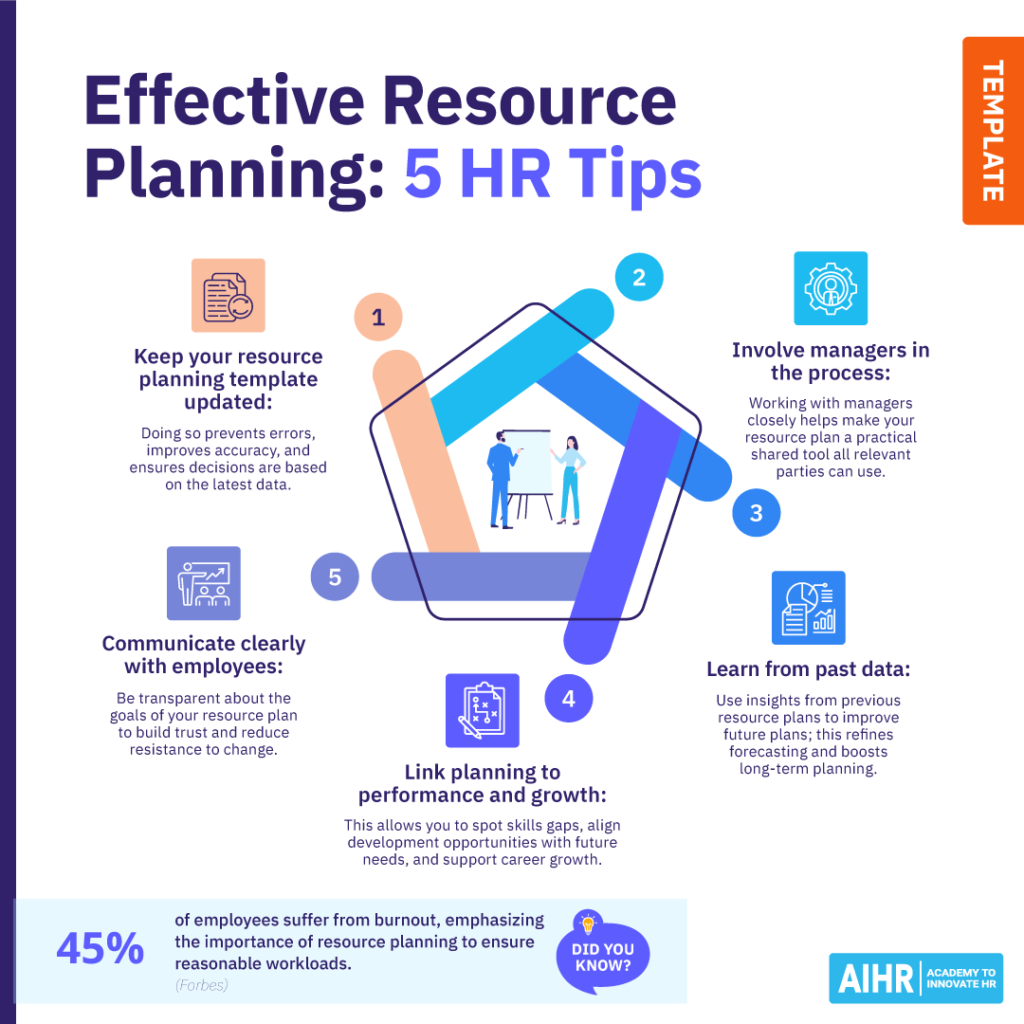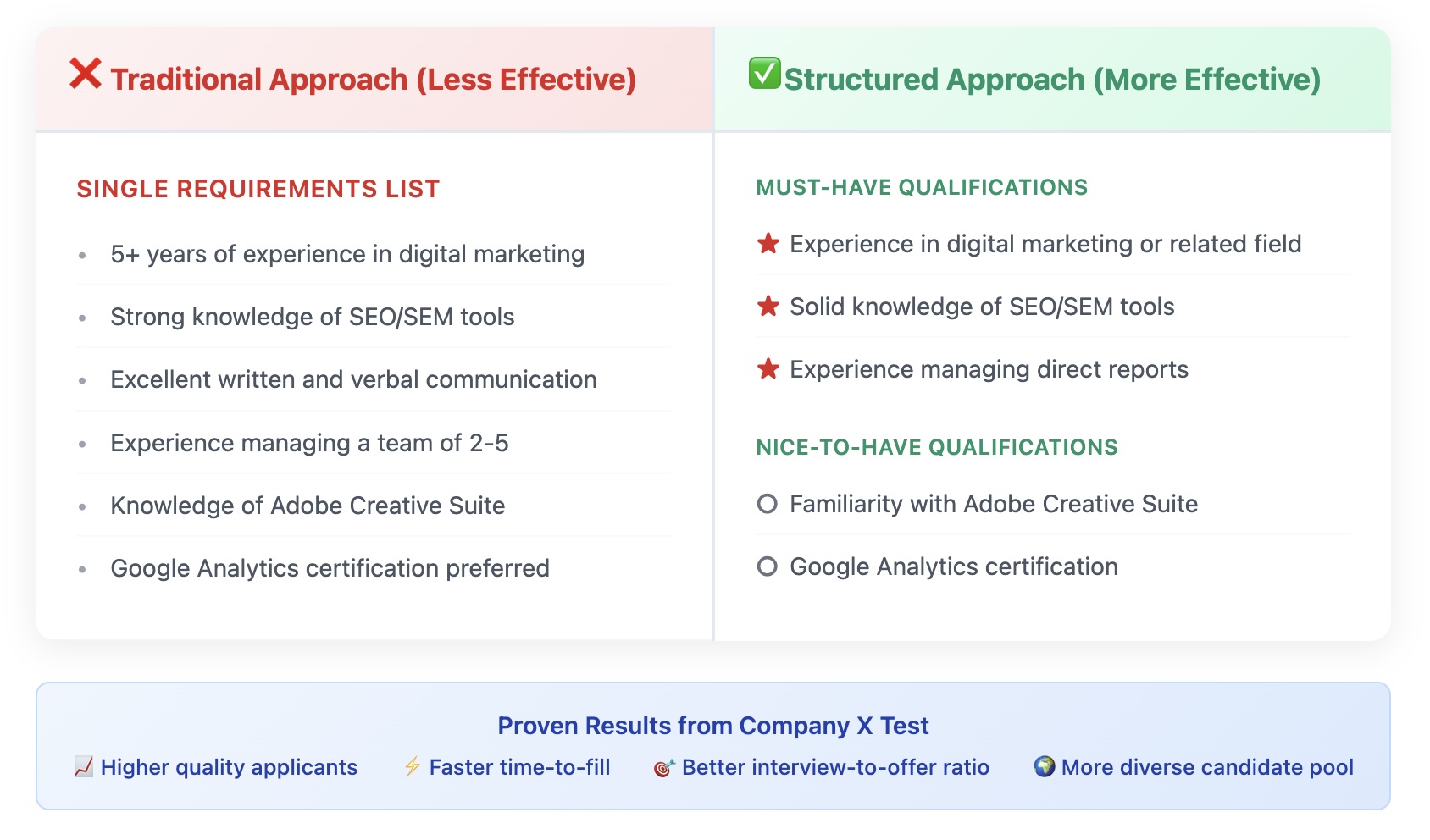A well-designed resource planning template is essential for aligning people, projects, and priorities. Poor planning can lead to excessive workloads that eventually result in burnout, affecting morale, productivity, and performance. Additionally, workload imbalance or key roles remaining vacant can cause deadlines to slip and engagement to drop.
Resource planning brings structure and clarity, helping you assess capacity and identify skills gaps. This article discusses HR’s role in resource planning and how a proper template can help you forecast hiring needs and manage workloads. It also includes a free, customizable resource planning template you can use to support your decision-making.
Contents
What is resource planning, and why is it important?
HR’s role in resource planning
Why use a resource planning template?
7 key elements of a resource planning template
Free resource planning template for HR
5 examples of resource planning
How HR can make resource planning more effective
What is resource planning, and why is it important?
Resource planning helps you allocate the right people, tools, and time to the right tasks. It helps avoid overworked teams and project delays, and a solid template allows you to keep everything on track. Here’s why it matters:
- Avoids overallocation and underutilization: A good plan balances workloads, preventing team members from being overwhelmed or underutilized.
- Prevents burnout: By understanding each team member’s capacity, you avoid overloading anyone, reducing burnout risk.
- Ensures timely task completion: A resource plan tracks responsibilities and deadlines, minimizing confusion and bottlenecks.
- Helps with planning ahead: Resource planning helps anticipate gaps and prepare for future needs like hiring, training, or major projects.
- Improves communication and accountability: Clear roles and expectations lead to better collaboration and fewer miscommunications.
HR’s role in resource planning
HR plays a crucial role in resource planning, ensuring the organization has the right people in the right roles at the right time. HR’s responsibilities in this area include assessing capacity and forecasting needs, collaborating with department leads, monitoring skills and development, and proactively problem-solving.
When resource planning, you need to track team capacity, identify gaps and future hiring needs. You must also work closely with managers to track workloads, prevent burnout, and determine where extra support is needed.
You also have to spot skills gaps and recommend training to close these gaps and meet organizational needs, as well as identify potential staffing issues early to prevent more serious challenges down the line.
Why use a resource planning template?
If you’re juggling multiple teams or projects, a resource planning template can make a big difference. Rather than starting from scratch every time, a good template for resource planning gives you a reliable, ready-made structure to work from, helping you plan faster, more accurately, and with less hassle.
It provides a consistent framework you can adapt to different teams or projects. Whether you’re mapping out roles, timelines, or workloads, you can skip the setup and go straight to planning. At the same time, a template can minimize errors as it allows everyone to stay aligned, avoiding confusion and duplication.
It also makes forecasting and progress tracking easier, helping generate reports with minimal effort. Additionally, a standardized template can aid in managing multiple deadlines, dependencies, and teams, spotting bottlenecks before they cause problems.

7 key elements of a resource planning template
A great resource planning template gives you a clear, functional overview of who’s doing what, when, and how intensively. Whether you’re planning across departments or managing a single project, the right template helps you track availability and keep things moving.
Here are seven key elements your resource planning template for HR should include:
1. Time period
Located above the table, this field sets the planning window (e.g., “Q1 2026”). It helps orient the plan within a specific timeframe and ensures everyone’s looking at the same slice of time when reviewing resource needs and allocations. It’s especially useful when maintaining multiple versions of the sheet for different quarters or months.
2. Project / Task
This column captures the name of the project or task each row refers to. It helps categorize work that is being done for clearer planning.
3. Project / task start and end dates
These dates define the duration of each assignment and help visualize the project timeline. It’s much easier to manage overlapping tasks and future planning when you can see who’s needed and when.
4. Effort hours
This is the total number of hours required for the project or task during the defined time period. It helps you estimate the workload involved.
5. Status
This indicates the current stage of the project. Typical values might include “To be started,” “Work in progress,” “Completed,” or “On Hold.” This gives a quick visual on progress and priorities.
6. Resources
These columns show how many hours each team member is expected to contribute to the project. They’re filled out per project row and let you see how work is distributed.
Sometimes you need a bit of context, whether it’s upcoming leave, part-time status, or special considerations. The notes section provides a space to add these extra details without cluttering the main fields.
Learn to manage your workforce with effective resource planning
Develop your skills in facilitating successful resource planning that will help avoid burnout, maximize productivity, and increase job satisfaction and employee engagement.
AIHR’s Talent Management and Succession Planning Certificate Program teaches you to determine talent supply needs, use talent management strategies to support long-term business needs, and manage the talent pipeline to support business continuity.
Free resource planning template for HR
AIHR has developed a resource planning template for HR that’s fully customizable to fit your team structure, projects, and planning needs. Whether you’re managing a small team or coordinating multiple projects, you can use this template to help you track availability, manage workloads, and plan ahead with confidence. Download it for free below.

5 examples of resource planning
To make resource planning work, HR professionals often rely on different templates tailored to specific needs. Here’s how you can use different types of resource planning templates to support better decision-making in the following resource planning scenarios:
Example 1: Hiring forecast
Use a general resource planning template to map out current team capacity against future demand. If the projected workload exceeds what existing staff can handle, you can use this template to highlight where new roles should be created, helping you justify hiring plans and timelines.
Example 2: Cross-functional planning
When team members have to split their time across departments or projects, you can also use a shared general resource planning template to track their commitments. This helps ensure no one is double-booked, and lets everyone know who is available for which tasks and when.
Example 3: Workforce allocation
When it comes to workforce allocation, a resource capacity planning template helps you oversee ongoing, business-as-usual work. It shows how many hours each team member is available per week, what they’re currently working on, and whether they have capacity for additional tasks.
Example 4: Project staffing
For new initiatives, you can use a project resource planning template to allocate people to short-term or long-term projects based on skills, availability, and priority. This helps avoid scrambling for staff at the last minute and ensures the right employees are in place and prepared from the start.
Example 5: Training and development planning
Use a resource planning template to track who needs upskilling and when training sessions are scheduled. This makes it easier to coordinate learning without clashing with project deadlines or peak work periods.
How HR can make resource planning more effective
A resource plan is only as good as how you use it. To get maximum value out of your template, you must make it part of a consistent, collaborative process. Here’s how you can make resource planning more effective:
- Keep your resource planning template updated: Reflect real-time information by regularly updating availability, project timelines, and role changes. This helps prevent errors, improve accuracy, and ensure all decisions are based on the latest data.
- Involve managers in the process: Team leads and project managers are closest to the day-to-day work. Work with them to review workloads, adjust allocations, and flag any concerns early. This makes the resource plan a shared, practical tool.
- Learn from past data: Use insights from previous resource plans to improve future ones. Look at where plans went off track, where demand was underestimated, or which roles were overstretched. This helps refine forecasting and long-term planning.
- Link planning to performance and growth: Integrate your template with HR activities (e.g., performance reviews, workforce planning). This lets you spot skills gaps, align development opportunities with future needs, and support career growth.
- Communicate clearly with employees: People will want to know how resource planning will affect their work. Be transparent about the goals of your resource plan to build trust and reduce resistance to change.

To sum up
Resource planning is a significant part of business strategy and execution. As an HR professional, you’re well placed to drive its success. With the right resource planning template, you can clarify complex staffing needs, ensure capacity aligns with business goals, and support your teams to perform at their highest level.
Beyond day-to-day operations, resource planning also enables more strategic talent conversations. Understanding capacity and capability across your organization helps identify skills gaps, support internal mobility, and align development opportunities with future needs. This makes effective resource planning a powerful tool for building a future-ready workforce.

Follow us on social media to stay up to date with the latest HR news and trends
Monique Verduyn has been a writer for more than 20 years, covering general business topics as well as the IT, financial services, entrepreneurship, advertising, pharmaceuticals, and entertainment
sectors. She has interviewed prominent corporate leaders and thinkers for many top business publications. She has a keen interest in communication strategy development and implementation, and has worked with several global organisations to improve collaboration, productivity and performance in a world where employees are more influential than ever before.












